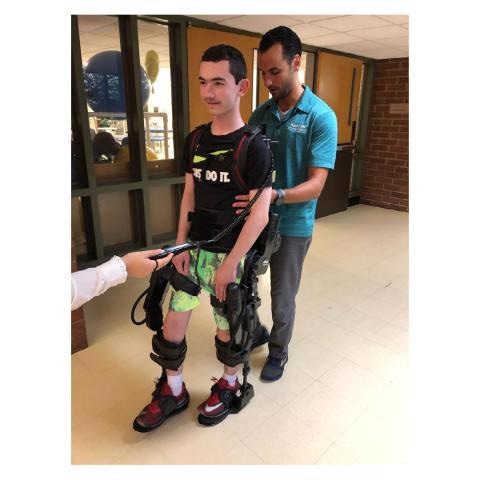Dec 15 2020
Gait training with the help of robotic exoskeletons enhanced motor function in adolescents and young adults with acquired brain injury, demonstrates a study performed by a group of New Jersey researchers.
 A study participant undergoing gait training in the EksoGT administered by a licensed physical therapist. Image Credit: Kessler Foundation.
A study participant undergoing gait training in the EksoGT administered by a licensed physical therapist. Image Credit: Kessler Foundation.
The article titled “Kinetic gait changes after robotic exoskeleton training in adolescents and young adults with acquired brain injury” was published in the Applied Bionics and Biomechanics journal on October 28th, 2020.
The study authors are Kiran Karunakaran, Ph.D., Naphtaly Ehrenberg, MS and Karen Nolan, Ph.D., from the Center for Mobility and Rehabilitation Engineering Research at Kessler Foundation; and JenFu Cheng, MD and Katherine Bentley, MD, from Children’s Specialized Hospital. Drs Karunakaran, Nolan, Cheng and Bentley are also associated with the Department of Physical Medicine and Rehabilitation at Rutgers New Jersey Medical School.
Acquired brain injury usually causes hemiparesis, which leads to considerable deficits in gait and balance that adversely impact functional ambulation and participation in everyday activities.
Although it is known that gait training with robotic exoskeletons provides an option for motor rehabilitation in individuals suffering hemiparesis, very few studies have been performed in adolescents and young adults. The results of a preliminary study in this age group exhibit the potential for this intervention, report Drs Karunakaran and Nolan.
Participants were one healthy control and seven individuals (aged between 13 and 28 years) suffering from acquired brain injury (ABI) and hemiparesis. The ABI group consisted of individuals with brain injuries caused by stroke, anoxia and trauma.
All participants received a total of twelve 45-minute sessions of repetitive, high-dose gait training using a robotic exoskeleton (EksoGT, Ekso Bionics, Inc.) over a period of four weeks. A licensed physical therapist supervised by one of the members of the research team administered the gait training.
At the end of the 4-week training, participants had progressed to a more normal gait pattern, including improved loading, a longer step length and faster walking speed.
Kiran Karunakaran, Center for Mobility and Rehabilitation Engineering Research, Kessler Foundation
The results have been found to be encouraging, but Dr Nolan acknowledged the drawbacks of the study, such as the lack of a control group and small sample size.
Further study is needed to confirm the training effect in this age group with ABI, optimal dosing for the training protocol, and the durability of functional improvements.
Karen Nolan, Center for Mobility and Rehabilitation Engineering Research, Kessler Foundation
This study was funded by Children’s Specialized Hospital, New Jersey Health Foundation (PC5-18), Kessler Foundation and Reitman Foundation.
Journal Reference
Karunakaran, K. K., et al. (2020) Kinetic Gait Changes after Robotic Exoskeleton Training in Adolescents and Young Adults with Acquired Brain Injury. Applied Bionics and Biomechanics. doi.org/10.1155/2020/8845772.